
Atlas F1 Magazine Writer
If you ask someone to mention a Formula One World Champion, chances are little you'll get John Surtees as an answer. Still, the quiet Briton did make some heads turn. After a hugely successful career on motorcycles, he made the move to four wheels and showed his speed had nothing to do with the number of wheels he was driving on. This time we'll take a look at how Big John did at his home Grand Prix, never in the limelight of the top spot, but always performing well.
Just a lap later, they both had to make way for Graham Hill, who was really storming through the field after having fallen all the way down at the start. The two Lotus drivers then continued to battle, gradually catching up with their teammate Innes Ireland. Eventually, Surtees made his way past Ireland, while Clark suffered technical problems which forced him to pit. Surtees was now in third, a long way behind leaders Hill and Brabham. However, Hill's brilliant drive up the field came to an abrupt end when the Briton spun off with just six laps to go. Jack Brabham went on to win easily, but in second place John Surtees was the man that really got noticed.
For 1961, Surtees moved to Reg Parnell's Yeoman Credit Racing Team. It was the year when the British teams made a large fall because of the regulation changes. This was no different for Surtees, as you can't expect miracles. However, he did improve on his previous season grid position. When the race started at Aintree, Big John was tenth on the grid, just behind Clark and Brabham and ahead of Hill. Normally speaking, tenth position wouldn't have been such a disaster, but when the race started, rain fell down by the gallon and in the thick spray, Surtees collided with an unknown entity and continued to race with a loose exhaust as a result of it. Despite the less than aerodynamic position of the exhaust, Surtees fought his way back up from 14th to ninth after eight laps. However, that was about it. With the troubled car, Surtees fell back to 17th, climbed back up into the top ten, but to no avail. After 23 laps Surtees ended his struggle when the Cooper's differential failed.
In 1963, Surtees moved to Ferrari, returning to Italy where he had achieved his biggest successes on motorcycles. With the British Grand Prix returning to Silverstone, the grid was much closer now than in previous years. Despite being only 0.8 seconds off pole, Surtees found himself in a rather disappointing fifth place, behind Clark, Gurney, Hill and Brabham. At the start, John got stuck behind Jim Clark who made quite a terrible start. From fifth and sixth position, the two started chasing the runaway leaders. There was little between the two, but eventually Clark moved up the order, while Surtees remained in sixth. When Bruce McLaren retired, Surtees jumped to fifth, catching up with Graham Hill. What followed was a splendid duel between the two, in which they exchanged positions several times throughout the race. With first Brabham and later McLaren retiring, the fighting duo moved up into second and third. Just when it appeared that Hill had won the battle, the BRM driver ran out of fuel. Surtees thankfully accepted the gift and moved into second place in the final lap.
While the British Grand Prix changed tracks yet again, now moving to Brands Hatch, John Surtees entered his second year with Ferrari. In practice, the top five of the previous year was again fastest and despite being closer to pole, Surtees was again number five. At the start, he was quicker off the line than Jack Brabham, moving into fourth position. Just a few minutes later he passed another Brabham, this time Gurney's, which was already pitting. As far as passing goes, that was about the entire race. Even though Graham Hill was surprisingly able to pressure Jim Clark all the way, the Scotsman didn't give way and the podium was Clark, Hill, Surtees in the end.
Even though Surtees stay at Ferrari was giving good results, the Briton's relationship with team manager Eugenio Dragoni became worse and worse, as the Italian was very much convinced his protege Lorenzo Bandini was the driver he wanted to support the most. Throughout the 1965 season things got quite unmanageable and Surtees left Ferrari. With the help of BP, Surtees acquired a seat with the Cooper team, driving their V12 Maserati-powered T81. The British Grand Prix was their first outing and with that in mind, the sixth position after practice wasn't bad at all. The Brabhams were in a league of their own, posting times over a second faster than the competition. However, as second Brabham driver Denny Hulme got badly away from the line, Surtees started into fifth and then quickly moved past Clark into fourth. There he got stuck behind Dan Gurney's Eagle. After six laps he finally made his way past and into third. Another six laps later, he moved into second, ahead of his teammate Jochen Rindt. Sadly for Big John, he then tumbled to fifth in the space of just a few laps. From there on, things weren't moving ahead and after 68 laps the Cooper's transmission failed and ended Surtees' race.
In the following year, things went a little better at Honda. First practice at Brands Hatch proved a real surprise, with Surtees posting the fifth quickest time. However, while Surtees wasn't able to improve his time, the rest of the drivers did and when the final grid was noted, Surtees was back in ninth place. That didn't prove too big a problem though, as Big John's start was of his usual quality. He made his way past Rindt, while Gurney and Brabham directly ran into problems. Throughout the race, Surtees was confined to battle Jackie Stewart for fifth and later fourth, when race leader Graham Hill retired. In the later stages of the race, Denny Hulme and Jacky Ickx joined the couple and eventually moved ahead. When surprise leader Jackie Oliver in a Lotus retired after 43 laps, the race settled and positions didn't change anymore. Surtees finished fifth, but for the second straight season he was two laps behind, which wasn't too pleasing.
After 1968, Honda pulled out of Formula One, so Surtees was once again left without a team. He decided to sign with BRM, but right from the start it proved to be the worst decision of his career. He and the team didn't get along at first and things quickly turned into a real crisis. With the unreliability of the car, its lack of speed and the relationships within the team about to erupt into a volcanic explosion, the sixth position in qualifying was indeed a pleasant surprise. But that's where it ended. In the first lap of the race, the BRM's suspension failed, sending its driver into an early retirement.
1971 was a similar experience. Again qualifying wasn't superb with 18th position, but in the race things went better. Halfway through the race, retirements and solid driving had gotten Big John 12th place. In the second half of the race he kept his cool and with more and more drivers retiring, he moved up and to the surprise of all finished in sixth, claiming his final World Championship point.
In twelve starts in the British Grand Prix, John Surtees achieved no less than five podium finishes, albeit without a win. Whenever Surtees finished, it was in the points.
In the winter before the 1960 season, Surtees first tested racing cars to see if he could adapt from two to four wheels. His racing debut then came on Easter Monday, 18 April 1960, when he drove a Formula Junior Cooper for Ken Tyrrell. Amazingly, he finished second behind Jim Clark. Clark's team boss Colin Chapman was immediately impressed and offered Surtees a drive in a works Lotus. Surtees' Formula One debut then came at Monaco, a little over a month after his first race. Fairly soon his transmission failed, but he was now in Formula One. John got his next opportunity at his home Grand Prix at Silverstone, three months after his car racing debut.
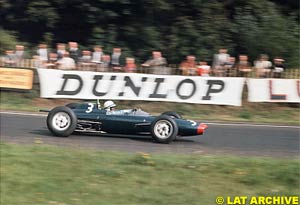 Qualifying already went a lot better than Monaco's 15th place. Surtees put the Lotus on a very decent 11th spot on the grid on the same row as Jim Clark. Until that point, the powers that be didn't take too much notice of the motorcyclist-in-a-car. That, however, would change soon enough. Once the race got underway, Surtees shot away from his grid position like a rocket. When the pack crossed the start-finish for the first time, Surtees had already moved into sixth place and a lap later he had made his way past the Ferrari of Wolfgang von Trips. His next victim was Bruce McLaren, whom he passed after seven laps. Another three laps later and Surtees moved into third when Jo Bonnier's BRM started to have problems. By now, the big guys had taken notice of John's capabilities, and his teammate Jim Clark was now wide awake and chasing. After 20 laps, Clark caught up with Surtees and passed him, only to drop back behind him less than ten laps later.
Qualifying already went a lot better than Monaco's 15th place. Surtees put the Lotus on a very decent 11th spot on the grid on the same row as Jim Clark. Until that point, the powers that be didn't take too much notice of the motorcyclist-in-a-car. That, however, would change soon enough. Once the race got underway, Surtees shot away from his grid position like a rocket. When the pack crossed the start-finish for the first time, Surtees had already moved into sixth place and a lap later he had made his way past the Ferrari of Wolfgang von Trips. His next victim was Bruce McLaren, whom he passed after seven laps. Another three laps later and Surtees moved into third when Jo Bonnier's BRM started to have problems. By now, the big guys had taken notice of John's capabilities, and his teammate Jim Clark was now wide awake and chasing. After 20 laps, Clark caught up with Surtees and passed him, only to drop back behind him less than ten laps later.
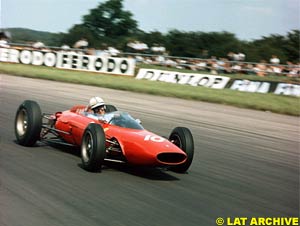 The next year became a completely different experience. Parnell built his team around Surtees, having engineer Eric Broadley design a Lola for the team and worked closely together with Surtees. The car was strong right from the start and Surtees became a regular point scorer throughout the season. In practice at Aintree, he was right up there with his former Lotus teammates Jim Clark and Innes Ireland. After his pole at Zandvoort early in the season, this was his second time on the front row, starting from second with Lotuses on both sides. With no rain to make the race a spectacle, it was as boring as it ever gets. Clark led easily from start to finish, with Surtees occupying the second spot for the entire distance with equal ease. At no time the race was a race, but that never bothered Big John, who secured his second second place at the British Grand Prix.
The next year became a completely different experience. Parnell built his team around Surtees, having engineer Eric Broadley design a Lola for the team and worked closely together with Surtees. The car was strong right from the start and Surtees became a regular point scorer throughout the season. In practice at Aintree, he was right up there with his former Lotus teammates Jim Clark and Innes Ireland. After his pole at Zandvoort early in the season, this was his second time on the front row, starting from second with Lotuses on both sides. With no rain to make the race a spectacle, it was as boring as it ever gets. Clark led easily from start to finish, with Surtees occupying the second spot for the entire distance with equal ease. At no time the race was a race, but that never bothered Big John, who secured his second second place at the British Grand Prix.
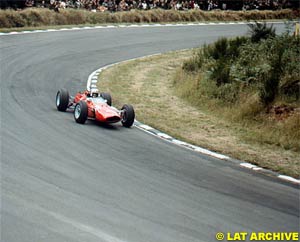 1965 saw Surtees as the reigning champion, still driving a Ferrari. For the third year in a row, Surtees came closer to pole position in time but not in position. While qualifying in the same time as Richie Ginther and Jackie Stewart, Surtees was again taking the start from fifth, this time at Silverstone. However, his start was a good one once again and he directly moved ahead of the already mentioned Ginther and Stewart. Ahead of Surtees, Clark and Hill quickly moved away, Clark as usual seemingly uncatchable at his home Grand Prix. The big battle occurred behind Surtees. Stewart, Ginther and Lotus driver Mike Spence battled closely until Ginther ran into problems at around one third race distance. When the battle settled to the advantage of Spence, the Lotus driver attempted to attack Surtees. Even though Spence sneaked ahead a few times, Surtees successfully fended him off. Far ahead, Jim Clark was suffering severe oil pressure problems and saw his lead melting quickly. In the end, three seconds were left and the podium remained the same as in '64: Clark, Hill, Surtees.
1965 saw Surtees as the reigning champion, still driving a Ferrari. For the third year in a row, Surtees came closer to pole position in time but not in position. While qualifying in the same time as Richie Ginther and Jackie Stewart, Surtees was again taking the start from fifth, this time at Silverstone. However, his start was a good one once again and he directly moved ahead of the already mentioned Ginther and Stewart. Ahead of Surtees, Clark and Hill quickly moved away, Clark as usual seemingly uncatchable at his home Grand Prix. The big battle occurred behind Surtees. Stewart, Ginther and Lotus driver Mike Spence battled closely until Ginther ran into problems at around one third race distance. When the battle settled to the advantage of Spence, the Lotus driver attempted to attack Surtees. Even though Spence sneaked ahead a few times, Surtees successfully fended him off. Far ahead, Jim Clark was suffering severe oil pressure problems and saw his lead melting quickly. In the end, three seconds were left and the podium remained the same as in '64: Clark, Hill, Surtees.
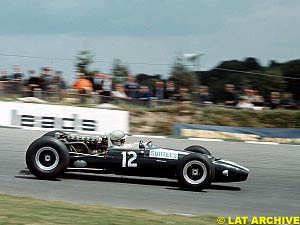 For 1967, Surtees was contracted by Honda, a marque he had already admired in his motorcycling days. Throughout the season, the team had serious reliability problems and the British Grand Prix didn't prove a turning point. Surtees qualified in seventh, but for the first time in years wasn't able to move ahead at the start. Instead, he dropped to tenth place after just six laps. With quite a few retirements ahead of him, he moved up some places, but overall the Honda was simply too slow. In the end, Big John got an unexpected sixth place, but he was no less than two laps behind.
For 1967, Surtees was contracted by Honda, a marque he had already admired in his motorcycling days. Throughout the season, the team had serious reliability problems and the British Grand Prix didn't prove a turning point. Surtees qualified in seventh, but for the first time in years wasn't able to move ahead at the start. Instead, he dropped to tenth place after just six laps. With quite a few retirements ahead of him, he moved up some places, but overall the Honda was simply too slow. In the end, Big John got an unexpected sixth place, but he was no less than two laps behind.
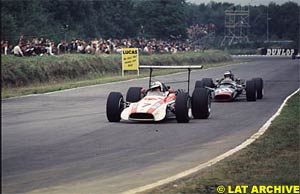 With the BRM disaster behind him, John Surtees decided to move his own team, which had already been operating in Formula 5000, into the big league. However, much like later happened to Graham Hill, the arrival of a team boss position didn't do the racing activities any good. Where the British Grand Prix once meant an almost certain season best performance for Surtees, this one was his worst of the season. Qualifying brought John a lowly 19th position in his first outing in the Surtees TS7. At the back end of the grid, Surtees engaged in a battle with Emerson Fittipaldi and Chris Amon. Slowly but surely the TS7 made its way up the ranks. Surtees drove well, passing Gurney and Hill along the way, while various retirements gave him some positions too. Just after the halfway point, Surtees settled in seventh place, but not for long. After 53 laps, Surtees' oil pressure faded and his race was over.
With the BRM disaster behind him, John Surtees decided to move his own team, which had already been operating in Formula 5000, into the big league. However, much like later happened to Graham Hill, the arrival of a team boss position didn't do the racing activities any good. Where the British Grand Prix once meant an almost certain season best performance for Surtees, this one was his worst of the season. Qualifying brought John a lowly 19th position in his first outing in the Surtees TS7. At the back end of the grid, Surtees engaged in a battle with Emerson Fittipaldi and Chris Amon. Slowly but surely the TS7 made its way up the ranks. Surtees drove well, passing Gurney and Hill along the way, while various retirements gave him some positions too. Just after the halfway point, Surtees settled in seventh place, but not for long. After 53 laps, Surtees' oil pressure faded and his race was over.
Please Contact Us for permission to republish this or any other material from Atlas F1.
|
Volume 7, Issue 28
Atlas F1 Special
Hakkinen 2001: Chronicles of Desperation
That's Entertainment?
British GP Preview
The British GP Preview
Technical Preview: Silverstone
Focus: Surtees in Britain
Columns
Elsewhere in Racing
The British GP Trivia Quiz
Bookworm Critique
The Weekly Grapevine
> Homepage |